Ferdinand VII Proclamation Medals
On 23 June 1808, Mexico received the news about the deplorable events that happened at Aranjuez on 19 March 1808: the uprising against Prime Minister Manuel Godoy that in turn caused the abdication by Charles IV from the throne of Spain and of the Indies in favour of his son, the Prince of Asturias, who ascended the throne with the name of Ferdinand VII. Shortly thereafter, Ferdinand himself abdicated and looked to Napoleon for aid. The latter held the former "under guard" for over five years at the Chateau de Valençay, a property owned by Napoleon's former foreign minister Talleyrand. During this time, Napoleon installed his brother, Joseph, as king - a move which was never accepted by the Spanish people nor her colonies. In Mexico, for example, coins continued to be struck in the name of Ferdinand, still recognized as the true Spanish king. Ferdinand was eventually allowed to return to the Spanish throne late in 1813, as Napoleon faced bigger issues closer to home.
When Joseph Bonaparte took the throne, the Cortes (Parliament) installed itself in Cadiz to act as Regent of the kingdom in the absence of Ferdinand VII.
Facing such a grave situation, the Royal Tribunal of Mexico and His Excellency, Viceroy José de Iturigaray, made a decision and the viceroy issued edicts and declarations directed to all the bishops, royal officers, quartermasters and mayors of all the cities and towns of the kingdom informing them of all that had happened and asking for their cooperation and help to strengthen the monarchy and ordered them in a threatening manner to immediately celebrate the proclamation of the unfortunate new sovereign.
Due to the difficult political times in which they were living, it was important to celebrate the Proclamation of His Majesty, King Ferdinand VII of Bourbon, in exile and denied his liberty. This public act was, at the same time, a declaration of loyalty and faithfulness to the unfortunate sovereign, a recognition of the legitimacy of the king and a repudiation of the usurper, Joseph Bonaparte, who occupied the throne.
For these reasons the Viceroy of New Spain and the Royal Tribunal, in unanimous accord, decided that the said ceremony should take place on 13 August 1808. In the case of the proclamation of Ferdinand VII we have an exaggerated number of proclamation medals that were struck by the cities, towns, important villages, institutions and individuals.
Mexico City
Issues were made in Mexico City as follows.
1808, first issue in gold, silver and copper with a diameter of 43 mm.
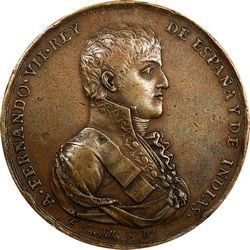
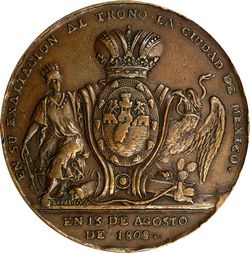
(Stack's Bowers)
The obverse displays a nice bust of the king facing right with his hair cut short and uncombed, dressed in a coat with an embroidered collar, the sash of the Order of the Golden Fleece and a cloak. On the border is the legend in Spanish: A FERNANDO VII REY DE ESPANA Y DE LAS INDIAS (TO FERDINAND VII KING OF SPAIN AND OF THE INDIES). Under the bust is the signature of the engraver, Francisco Gordillo (F. Gordillo F. Mo).
The reverse is also beautiful. In the centre of the field is the oval coat of arms of Mexico City: a tower supported by two lions on a bridge over the waters of the lake. The shield is topped with a large imperial crown. This symbol says that he is King of Spain and Emperor of the Indies. The shield is supported on the right by the figure of an Indian woman with feather decoration in her hair and on the left by an eagle and serpent. On the margin the legend continues from the principal face: EN SU EXALTACIÓN AL TRONO – LA CIUDAD DE MÉXICO (ON YOUR ELEVATION TO THE THRONE – THE CITY OF MEXICO), and on the exergue in two lines EN 13 DE AGOSTO DE 1808 (ON 13 OF AUGUST OF 1808).
[image needed]
1808, second issue only in silver and copper with diameter of 42 mm.
The king's bust suffered a modification: on his head is a laurel crown and his face is completely different from the preceding specimen. Everything else is equal.
[image needed]
1808, third issue in gold, silver, copper and gold plated bronze with diameter of 43 mm.
The king's bust is a three quarters view facing right and dressed in the same clothes as the preceding examples. The legends and the decorative elements on the reverse are the same. These emissions also display the signature of the engraver Francisco Gordillo and the date 13 August 1808.
1808, fourth issue of a coin type medal in silver with 40 mm. diameter.
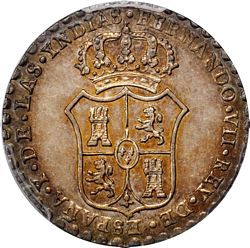
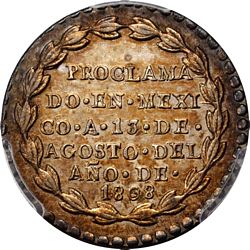
On the obverse are four different representations of the Spanish coat of arms and the motto on the border in Spanish: FERNANDO VII REY DE ESPAÑA Y DE LAS INDIAS (FERDINAND VII KING OF SPAIN AND OF THE INDIES). On the reverse in five lines reads: PROCLAMDO EN MÉXICO EL 13 DE AGOST DEL AÑO DE 1808 (PROCLAIMED IN MEXICO ON 13 AUGUST OF THE YEAR 1808.)
1808, two more issues, equal to the preceding one but with smaller diameter of 27 and 30 mm. in silver and copper with the same designs and legends. These were surely the pieces that were thrown to the crowd during the Proclamation ceremony.
The Bustamante Medal
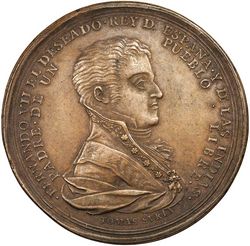
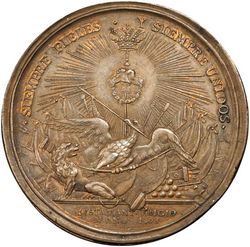
Carlos Maria Bustamante, a passionate admirer of the king, ordered from the Royal Mint on his own account an issue of medals of 51 mm. diameter in silver, gold plated bronze and copper.
On the obverse is a stern faced monarch facing right with the hair combed to the back, which completely changed the king's appearance, and dressed in a coat with high collar and cloak. On the border is the circular motto in two lines: FERNANDO VII EL DESEADO REY DE ESPAÑA Y DE LAS INDIAS – PADRE DE UN PUEBLO LIBRE (FERDINAND VII THE DESIRED KING OF SPAIN AND OF THE INDIES - FATHER OF A FREE PEOPLE).
The reverse shows an allegory consisting of a radiant royal crown at the centre, some flags, a lion and a fallen French eagle with the legend on the border: SIEMPRE FIELES Y SIEMPRE UNIDOS. BUSTAMANTE ERIGIO AÑO DE 1808. (ALWAYS LOYAL. AND ALWAYS UNITED. BUSTAMANTE MADE YEAR OF 1808). The engraver of these pieces was Tomás Suria.
El Comercio
1809, In gold, silver, gold plated bronze and copper with diameter 57 x 44 mm.
The obverse displays a very well done bust of the king facing right. On the border is the legend in Spanish: AMADO FERNANDO VII EL COMERCIO DE N.E. DERRAMARÁ GUSTOSO SU SANGRE EN TU DEFENSA (BELOVED FERDINAND VII. THE COMMERCE OF N. E. WILL GLADLY SPILL ITS BLOOD IN YOUR DEFENSE). On the reverse are two mythological figures, Mars, God of War, and Mercury, God of Commerce with their appropriate attributes and the legend on the border LA INDUSTRIA Y EL VALOR SE UNIRAN EN DEFENSA DEL MONARCA. -TOMAS SURIA EN MEXICO AGISTO DE 1809 (INDUSTRY AND VALOR UNITE IN DEFENSE OF THE MONARCH -TOMAS SURIA IN MEXICO AUGUST 1809). On the upper part of these medals is a ring decorated with foliage.
El Colegio Mexicano
1809. In gold, silver, gold plated bronze and copper with diameter 46 x 37 mm.
On the obverse the bust facing right dressed with a coat and the sash of the Golden Fleece. The legends in Latin on the border allude to his captivity. On the reverse a royal crown is in the upper part and below it a painting of three Indians conversing. On the lower part are two overlapping worlds and the signature of the engraver of José Maria Guerrero, a noted artist who was outstanding as a sculptor and engraver.
El Colegio de San Idelfonso
1808. First issue, in silver, gold plated bronze and copper with diameter 46 x 37.5 mm.
On the obverse is the bust of the king facing left, the hair is combed forward and he is dressed in a coat with high collar and the sash of the Golden Fleece. On the margin is the motto in Latin: (FERDINAND VII KING OF SPAIN AND OF THE INDIES). In the centre of the field on the reverse is a group of hearts and the signature of the engraver J. M. GUERRERO. A. 1808. On the upper part there is a ring decorated with palm fronds and foliage.
1808 Second issue, in silver, gold plated bronze and copper.
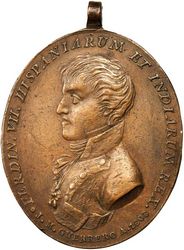

This specimen is exactly the same as the preceding one except that the ring does not have any decoration.
El Seminario Tridentino
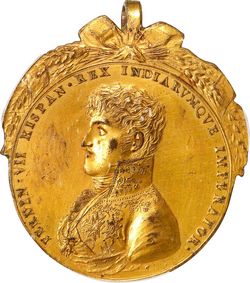
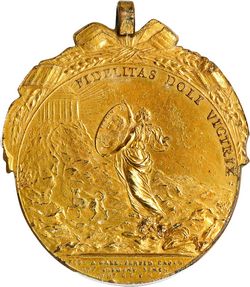
1809. First issue in silver, gold plated bronze and copper with diameter of 47 mm.
On the obverse is a bust of the king facing left with the hair cut short and in complete disorder and tangled, dressed in a coat and the sash of the Golden Fleece. On the border is the motto in Latin: FERDIN. VII HISPAN. REX INDIARUMQUE IMPERADOR. On the upper part is a ring with palm fronds on one side and foliage on the other. On the reverse is an unidentified female figure.
1809. Second issue, only in silver with diameter of 47 mm.
This medal is exactly like the preceding but does not have any decoration on the ring.
Real y Pontíficia Universidad de México
1808. First issue in silver, gold plated bronze and copper with diameter 47 x 38 mm.
On the obverse is the bust of the sovereign facing right with a laurel crown and dressed in a Roman style toga. On the border is the legend in Latin with the name of the king and his titles and attributes. The reverse has the legends alluding to the date in Roman numerals and the name of the engraver: GUERRERO. These medals have a ring for hanging decorated with palm fronds on both sides.
1808. Second issue, in silver, gold plated bronze and copper with diameter of 47 x 38 mm.
These medals are exactly the same as the preceding with the exception that there is not a support or adornment on the upper part. As the previous issue, it is the work of the sculptor and engraver Jose Maria Guerrero, who achieved some beautiful specimens.
Third issue. Without a date. In gold plated bronze only with diameter of 35 x 29 mm.
The obverse has the bust of the king facing right dressed with a coat, sash and cloak. On the reverse the legends are in Latin. On the upper part are two long thin supports for the ring. Certainly these medals were made for the university students with less money.
1809. Fourth issue, in silver and copper with diameter of 50 mm.
This is one of the more beautiful medals that was struck in the Royal Mint in the name of King Ferdinand VII. The obverse displays the monarch's bust facing left dressed in a coat with nicely embroidered high collar and the sash of the Order of the Golden Fleece. His short hair is in disorder. On the border is the motto in Latin: FERNANDVS VII BORBONIVS REX CATHOLICVS. On the reverse in the foreground is the figure of Minerva, Goddess of Knowledge, attired with a helmet, tunic, shield and lance. On the exergue is the inscription J. M. GUERRERO INVENTO Y G. EN Mo A. DE 1809 (J. M. GUERRERO INVENTED AND ENGRAVED IN Mo YEAR OF 1809).
(The foregoing section on Mexico City based on Antonio Deana Salmerón, La Proclamación del Rey Fernando VII en el Reino de la Nueva España)
Actopan
Obverse: FERNANDO VII REY DE ESPANA Y DE LAS INDIAS / (Coat-of-Arms)
Reverse: PROCLAMADO ENS. / NICOLAS ACTOPAN / POR DN JOSE MAXIMIA / FERNANDEZ / ADMINISTRADOR DIA / RL. RENTA D CORES / A. 1808
Parras
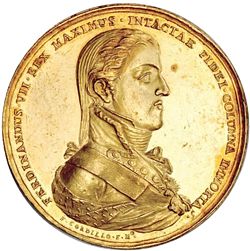
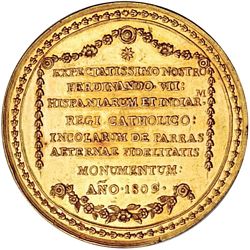
F-101 Gold Proclamation Medal (Stack’s Bowers Louis E. Eliasberg, Sr. Collection Auction, 15 April 2005, lot 3218)
The obverse has the bust of Fernando VII wearing the Order of the Golden Fleece. Signed by F. Gordillo of the Mexico City mint under bust. This medal was unknown to Grove in gold.
Puebla
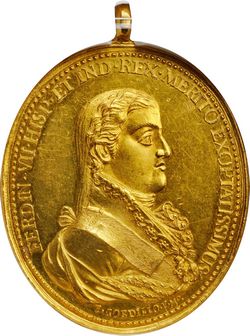
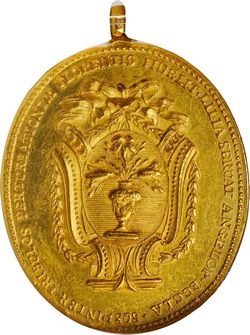
F-122 Gold Proclamation Medal (Stack’s Bowers NYINC Auction, 18 January 2020, lot 21176)
The reverse has the coat of arms of Puebla containing a vase and three lilies, with legend around.
Querétaro
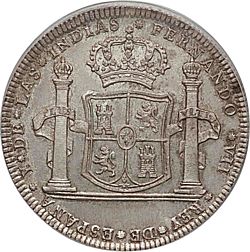
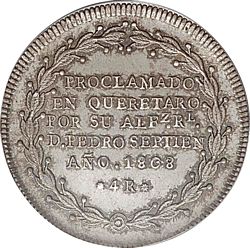
On obverse *FERNANDO *VII *REY *DE *ESPAÑA *Y *DE *LAS *INDIAS and on reverse PROCLAMADO / EN QUERETARO / POR SU ALFZ. RL. / D.PEDRO SEPTIEN / AÑO . 1808 / *4R*
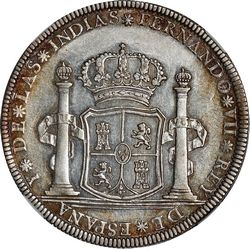
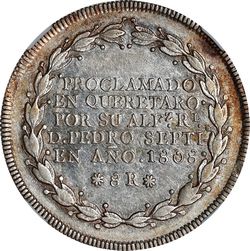
F-135 Silver Proclamation 8 Reales (Stack’s Bowers Auction, 15 August 2023, lot 51307)
Zamora
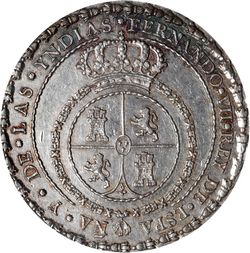
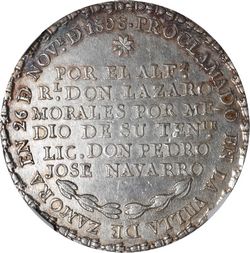
F-206 Silver Medal (Stack’s Bowers NYINC Auction, 15 January 2022, lot 2354)
The obverse has the crowned coat-of-arms between crowned and garlanded Pillars of Hercules and the reverse: the legend, date, and the denomination of eight reales within a wreath.
